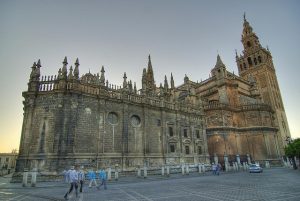Great Fall Foliage Trips Across the Country
Originally posted by Jordan Simon in Fodor’s Magazine
Nobel Prize-winner Albert Camus observed, “autumn is a second spring when every leaf is a flower.” (Yes, even despairing existentialists rhapsodize over fall foliage.) Most people associate New England with the spectacular seasonal displays, but dazzling fall colors a wait in every corner of the US. Leaf-peeping season runs surprisingly longer than expected; very generally, color appears earliest in northern regions and higher elevations then creeps southward and toward valleys and the coast. And various trees and shrubs turn at different times; just think of it as nature putting on a show every week. Here’s a roundup of 10 fantastic fall foliage areas. Get ready to color your world magenta too saffron.
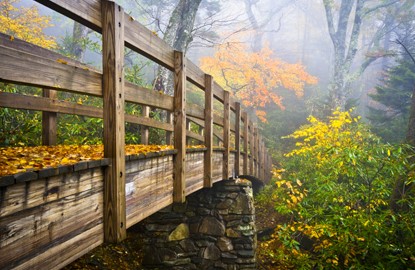
BLUE RIDGE PARKWAY, NORTH CAROLINA
Why We Like It: The 469-mile Blue Ridge Parkway that begins in Shenandoah National Park and ends in Tennessee’s Great Smoky Mountains is often nicknamed “America’s Favorite Drive.” Hundreds of native species of hardwood trees ignite the ancient Blue Ridge Mountains, so named for their distinctive blue tinge. Yellow poplar and hickories rival the sun for brightness; sassafras detonates in orange; red maples show off their finery from ruby to russet. All brilliantly contrast with the southern conifers. Genteel, historic Asheville contributes the must-see Biltmore Estate, a remarkable 250-room French Renaissance château built in the 1890s as the home of George Vanderbilt, America’s largest private residence. Visits include the magnificent formal gardens, a fine art collection including Sargents and Renoirs, craft demos at Antler Hill Village, a turn-of-the-20th-century farm, even the well-regarded Biltmore Estate Winery.
When to Go: The show for fall foliage, depending elevation, can last until Thanksgiving, but peak travel is generally mid-October to early November. Dogwood, sourwood, and black gum turn crimson in late September, then sugar maples, scarlet oaks, sweet gum, red maple, and hickories explode with color.
Where to Stay: Visit http://Guruescape.com and search for Hotel accommodations.
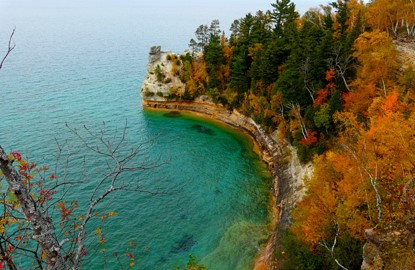
UPPER MICHIGAN PENINSULA
Why We Like It: The densely forested Upper Peninsula, nestling amid three Great Lakes, features more than 100 species of trees, like oak, ash, birch, beech, maple, aspen, tamarack, and sycamore whose flames are particularly vivid against deep blue waters. Stellar showcases are in the western half’s Ottawa National Forest and eastern half’s Hiawatha National Forest by the shores of Longfellow’s Gitche Gumee, Lake Superior. Scenic biking and hiking trails, as well as ponds and streams, filigree the woods, where whitetail deer, moose, and beaver roam. The western highlights include the rugged Porcupine Mountains Wilderness State Park; Mount Brockway 735 feet above Lake Superior with breathtaking views of turning leaves; and touring the Keweenaw Peninsula’s lighthouses and copper mines. The central-eastern region counters with the natural arches and towering sand dunes of the Pictured Rocks National Lakeshore, agate-strewn beaches, more historic lighthouses, and Tahquamenon Falls. As bonuses, savor natural bounty like Lake Superior whitefish, and get to know the Youpers’ zany sense of humor (winter activities include “Michelin” Bowling in fat suits).
When to Go: Fall Foliage Viewing begins in mid-September in the Ottawa National Forest, while the Hiawatha National Forest usually starts a bit later; foliage peaks the first and second weeks in October.
Where to Stay: Visit http://Guruescape.com and search for Hotel accommodations
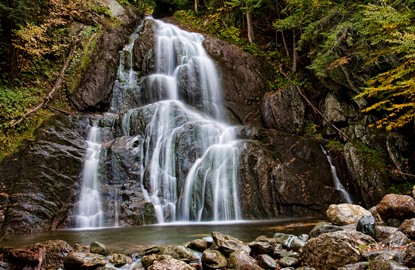
GREEN MOUNTAIN BYWAY, VERMONT
Why We Like It: Vermont’s amazingly scenic Route 100 roughly bisects the state; this 11-mile stretch between Waterbury and Stowe passes Currier and Ives-worthy covered bridges spanning sun-silvered streams, whitewashed church steeples, 18th-century brick houses, and cows grazing in meadows. The route accesses three state parks and two state forests, dominated by Mount Mansfield, Vermont’s highest peak, not to mention farmsteads, mills, and historic villages. Among the myriad attractions beyond the maple, beech, and birch putting on a show: the Waterbury Railroad Station & Green Mountain Coffee Roasters Visitor Center, Ben & Jerry’s ice cream factory(check out the flavor graveyard), the Cheese Trail (encompassing over 30 artisanal fromageurs),Cold Hollow Cider Mill, and Vermont Ski Museum. Ski areas like Stowe and Smuggler’s Notch offer gondola and mountain trails up the same steep inclines that skiers and shredders attack in winter, accessing miles of blazing trails.
When to Go: Fall Foliage Viewing in northern Vermont begins the second week in September at higher elevation, usually peaking by the first week of October.
Where to Stay: Visit http://Guruescape.com and search for Hotel accommodations
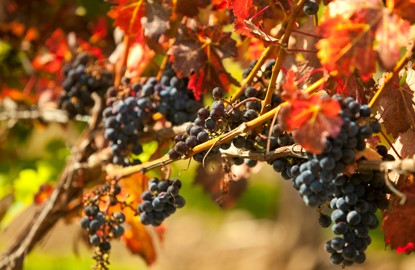
SONOMA, CALIFORNIA
Why We Like It: Leaf-peeping and wine tasting is as felicitous a pairing as Sonoma Pinot Noir and locally grown lamb. Drink in the views, literally, as even vine leaves turn crimson and gold. Since it coincides with harvest, festivals abound. Stop by farmers’ markets and roadside produce stands for picnic fixings. Many wineries sell gourmet goodies or offer lovely picnic areas. Along the way, you can admire the ornate Victorians in Petaluma; the farms around Santa Rosa, including Crane Melon Farm (where that aromatic sweet fruit was developed); the restaurants in Healdsburg; the galleries in arty Sebastopol and Cloverdale; and the towering denizens of the Armstrong Redwoods State Natural Reserve. The Russian River appellation produces both sumptuous Pinot Noirs and fab fall foliage. Additional appellations worth visiting include the Dry Creek and Alexander Valleys (where the Francis Ford Coppola Winery features fun movie memorabilia). Top drives off the congested main artery, Route 101, include Warm Springs Road and Arnold Drive, winding through resplendent autumn colors.
When to Go: Fall foliage in Sonoma County begins in mid-October and continues until Thanksgiving, with the hillsides along Highway 101 painted vibrant red and orange.
Where to Stay: Visit http://Guruescape.com and search for Hotel accommodations

ADIRONDACKS, NEW YORK
Why We Like It: The so-called “America’s First Wilderness,” the Adirondacks became a popular retreat for the Northeast elite, who erected grand hunting and fishing camps in the 19th century. Then as now, visitors enjoy the spectacularly varied terrain, which spreads from the higher peaks, home to the Winter Olympics’ Whiteface Mountain, to the shores of Lake Champlain to the foothills along the St. Lawrence Seaway. The 12 designated Scenic Byways all slice through wildlife-filled wooded regions that burst into pyrotechnics. The hamlets along the way percolate with farmer’s markets, pick-your-own apple orchards, craft fairs, and harvest festivals. The 170-mile Olympic Trail, snaking from Lake Ontario to Lake Champlain, offers such highlights as Lake Placid (where you can tackle the thrilling bobsled run) and glorious Ausable Chasm, where recreation runs from rafting to rappelling.
When to Go: Fall Foliage, Maple, oak, birch, and beech burst into flame the last two weeks of September or early to mid-October; the higher elevations fade first while areas around Lake George and Lake Champlain linger into late October.
Where to Stay: Visit http://Guruescape.com and search for Hotel accommodations

GLACIER NATIONAL PARK, MONTANA
Why We Like It: The massive Rockies of the Continental Divide form the spine of Glacier National Park and its Canadian sister park, Waterton Lakes, designated as both Biosphere Reserves and World Heritage sites by UNESCO. The foliage explodes in shades of orange, red, and gold, which are brilliant against the backdrop of evergreens and early snow. Mountain goats, bighorn sheep, elk, and grizzlies patrol the diverse habitats, carved by receding glaciers clawing the earth in their wake. Bear in mind that the park’s signature drive, the extraordinary Going-to-the-Sun Road, a National Historic Civil Engineering Landmark, has been winterized, but sections do still close depending on weather. For more stunning views of the park and Flathead Valley and Lake, drive the corkscrewing eight-mile Summit Road to the top of Big Mountain in Whitefish. Rafting companies also arrange fall foliage floats down the Flathead River.
When to Go: Fall foliage Autumn colors arrive in early September with vibrant orange Rocky Mountain maple and crimson huckleberries. Aspen, birch, and cottonwood set lower elevations aglow by late September. Western larch crowns the park’s lake and river corridors with a golden halo in mid- to late October.
Where to Stay: Visit http://Guruescape.com and search for Hotel accommodations
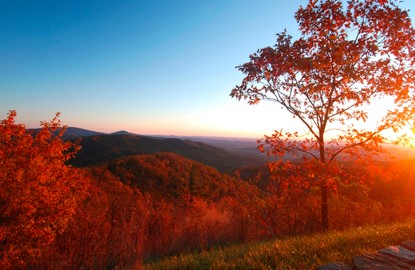
SHENANDOAH NATIONAL PARK, VIRGINIA
Why We Like It: Shenandoah National Park is particularly celebrated for its 105-mile Skyline Drive, designated both a National Scenic Byway and a National Historic Landmark. Traversing the ridge of the mountains, the road offers nearly 75 scenic overlooks of the hillsides sending red and gold streamers into the surrounding verdant valleys. Ruddier Fraser magnolias, red oaks, and chestnuts serve as backdrop to the gaudier colors. Sumac, locust, and sassafras turn from red to buttery yellow. Hickory, walnut, tulip poplar, white oak, birch, American beech, elm, and sycamore shimmer in gold. Scarlet oak, red maple, black gum, sweet gum, and sourwood preen in a variety of fiery reds. Berry bushes contribute deep burgundy and amethyst to the color wheel, which Virginia creepers cascade in crimson over the gray roadside rock outcroppings. Wildlife, including black bear and white-tailed deer, teems throughout the region. If it’s not clear yet, this is a leaf peeper’s heaven. You can hike, bike, or horseback ride off the drive, with 500 miles of trails carpeted with vibrant leaves accessing waterfalls, rock scrambles and, of course, foliage fireworks, sensationally contrasting with evergreens.
When to Go: Fall Foliage peak is optimal in October, though the higher elevations begin losing leaves by mid-month.
Where to Stay: Visit http://Guruescape.com and search for Hotel accommodations
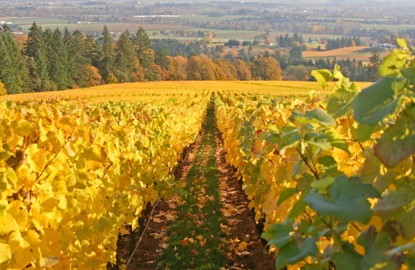
WILLAMETTE VALLEY, OREGON
Why We Like It: Like Sonoma, the Willamette Valley, home to more than 250 wineries, offers the opportunity to experience fall foliage during a world-class wine region’s harvest, with perhaps not quite as pressing a crush of visitors. The valley brackets the Willamette River from the Cascades through rolling farmland to the Portland metro area, with I-5 and Highways 99E and 99W offering prime leaf peeping. The area is surprisingly reminiscent of New England, replete with churches, barns, and covered bridges. Fall foliage bedecks such roads as Highway 126 following the McKenzie River (whose famed whitewater trout pairs beautifully with local Pinot Gris). Wineries from the Willamette Valley AVA and six smaller American Viticultural Areas within its northern section, celebrated for their sumptuous Pinot Noirs, are equally colorful with the changing vines; among others, check out Argyle (great sparklers, too), Beaux Frères, Shea, Elk Cove, and Erath.
When to Go: Though fall foliage start turning in mid-August and often last until Thanksgiving, the fireworks really start mid-October, with eye-popping displays peaking the weeks before and after Halloween.
Where to Stay: Visit http://Guruescape.com and search for Hotel accommodations
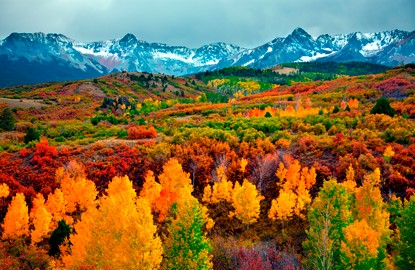
ASPEN (AND SURROUNDINGS), COLORADO
Why We Like It: Skiers and boarders talk about big air, but truly spectacular fall foliage can also be found atop these mountains. The aspen tree, shimmering in autumn, is synonymous with Colorado and its namesake town, echoing the old mining cry, “There’s gold in them thar hills.” And Cottonwood trees lining the Colorado River are equally luminous and abundant. Four-wheel drive is recommended for the rugged, occasionally dirt roads that access the truly unspoiled spots. The most photographed mount is the purple-and-white streaked Maroon Bells. Surrounding roads like Castle Creek also pass well-preserved ghost towns like Ashcroft, painting a picture of the area’s rich history. Other majestic drives include Glenwood Canyon, following the Colorado River, and the 30-mile stretch of the Kebler Pass road between Paonia Reservoir and Crested Butte that includes the world’s largest aspen forest. As a bonus, hotel rates usually plunge and Aspen’s glam eateries offer discounted menus.
When to Go: Peak fall foliage color in the main aspen forests ranges anywhere from September 20 to October 10 depending on elevation; target the last week in September or first in October for maximum effect when the golden alpine tundra is intermixed with splashes of scarlet.
Where to Stay: Visit http://Guruescape.com and search for Hotel accommodations

GUADALUPE MOUNTAINS NATIONAL PARK, TEXAS
Why We Like It: Tucked away in West Texas, Guadalupe Mountains National Park is renowned for its ancient marine fossils, birding, historic ranches, and stage stations, and such brooding landmarks as the massive rock face of El Capitan. Snaking through stands of piñon, ponderosa pine, juniper, and Douglas fir, the Guadalupe Peak Trail offers outstanding vistas framed against the vast, stark Chihuahuan Desert. Fall foliage fans flock to such rugged woodland canyons as McKittrick, where turning Bigtooth maple and ash trees paint a dramatic contrast with the arid desert and the ribbon of azure sky trapped between the steep walls. Caves stipple the range; a bonus is visiting the world-class crystal gardens in Carlsbad Caverns National Park just across the border in New Mexico.
When to Go: Fall foliage colors season runs from approximately Early-October through mid-November, peaking in late October, especially in the canyons.
LOOKING FOR MORE FALL TRIP IDEAS?
.Visit http://Guruescape.com
Guruescape is a leading hotel & travel price comparison site. We use advanced search technology to find the best prices from hundreds of travel suppliers. You can find the best rates on hotel rooms, flights and rental cars.
You could save hundreds on you next vacation by booking with us.
Photo Credits: Green Mountain Byway, Vermont: Moss Glen Falls by Matthew Paulson Attribution-NonCommercial-NoDerivs License; Adirondacks, New York: The road to nowhere by LidaAttribution-ShareAlike License; Shenandoah National Park, Virginia: Svecchiotti | Dreamstime.com; Blue Ridge Mountains/Asheville, North Carolina: Dave Allen/iStockphoto; Upper Michigan Peninsula / Great Lakes: Miners Castle in autumn color by Kiyo Attribution-NoDerivs License; Glacier National Park, Montana: 6015714281/Shutterstock; Aspen (and surrounds), Colorado: Peter Kunasz/Shutterstock; Sonoma: Paul Giamou 2010/iStockphoto; Willamette Valley: Bruce Block/Getty Images/iStockphoto; Guadalupe Mountains National Park, Texas: Vladimir Gorbenko |Dreamstime.com


